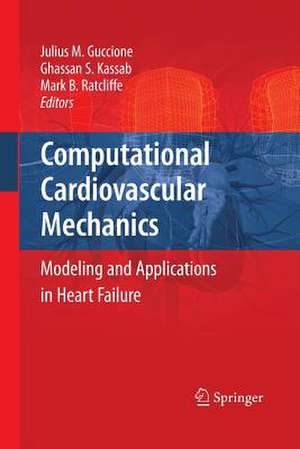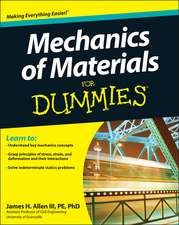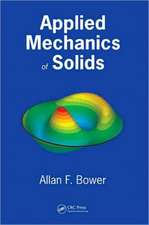Computational Cardiovascular Mechanics: Modeling and Applications in Heart Failure
Editat de Julius M. Guccione, Ghassan Kassab, Mark B. Ratcliffeen Limba Engleză Paperback – 26 noi 2014
Edited by experts in the field, researchers involved with biomedical and mechanical engineering will find Computational Cardiovascular Mechanics a valuable reference.
| Toate formatele și edițiile | Preț | Express |
|---|---|---|
| Paperback (1) | 1097.18 lei 6-8 săpt. | |
| Springer Us – 26 noi 2014 | 1097.18 lei 6-8 săpt. | |
| Hardback (1) | 1103.03 lei 6-8 săpt. | |
| Springer Us – 22 ian 2010 | 1103.03 lei 6-8 săpt. |
Preț: 1097.18 lei
Preț vechi: 1154.93 lei
-5% Nou
Puncte Express: 1646
Preț estimativ în valută:
210.01€ • 228.20$ • 176.52£
210.01€ • 228.20$ • 176.52£
Carte tipărită la comandă
Livrare economică 22 aprilie-06 mai
Preluare comenzi: 021 569.72.76
Specificații
ISBN-13: 9781489985057
ISBN-10: 1489985050
Pagini: 348
Ilustrații: XXVII, 320 p.
Dimensiuni: 155 x 235 x 18 mm
Greutate: 0.49 kg
Ediția:2010
Editura: Springer Us
Colecția Springer
Locul publicării:New York, NY, United States
ISBN-10: 1489985050
Pagini: 348
Ilustrații: XXVII, 320 p.
Dimensiuni: 155 x 235 x 18 mm
Greutate: 0.49 kg
Ediția:2010
Editura: Springer Us
Colecția Springer
Locul publicării:New York, NY, United States
Public țintă
ResearchCuprins
Computational Modeling of Cardiovascular Mechanics.- In Vivo Left Ventricular Geometry and Boundary Conditions.- Imaging-Based Assessment and Modeling of the Structures of the Myocardium.- Constitutive Equations and Model Validation.- Determination of Myocardial Material Properties by Optimization.- Computational Models of Cardiac Electrical Activation.- Geometrical Features of the Vascular System.- Vascular Geometry Reconstruction and Grid Generation.- Governing Equations of Blood Flow and Respective Numerical Methods.- Fluid–Structure Interaction (FSI) Modeling in the Cardiovascular System.- Turbulence in the Cardiovascular System: Aortic Aneurysm as an Illustrative Example.- Applications in Heart Failure.- Noninvasive Assessment of Left Ventricular Remodeling: Geometry, Wall Stress, and Function.- Surgical Left Ventricular Remodeling Procedures.- Passive Left Ventricular Constraint Devices.- Left Ventricular Implantation of Biomaterials.- Computational Modeling of Heart Failure with Application to Cardiac Resynchronization Therapy.- Computational Modeling of Aortic Heart Valve Mechanics Across Multiple Scales.- Blood Flow in an Out-of-Plane Aorto-left Coronary Sequential Bypass Graft.- Computational Fluid Dynamics Models of Ventricular Assist Devices.
Textul de pe ultima copertă
Computational Cardiovascular Mechanics promotes the application of patient-specific cardiovascular mechanics models to clinical medicine, which aid medical diagnosis and enhance treatment for cardiovascular disease.
Organized in a two-part structure, this volume presents a comprehensive overview of computational modeling from both solid mechanics and fluid dynamics perspectives. Part I offers chapters devoted to various techniques involving finite element modeling of ventricular mechanics and computational fluid dynamics, with a focus in cardiovascular mechanics. Part II covers heart failure applications which utilize techniques in solid mechanics and fluid dynamics. In the former, both diagnostic (i.e., global and regional indices of myocardial contractility) as well as therapeutic approaches (surgical ventricular remodeling procedures, passive ventricular constraint devices, ventricular implantation of biomaterials and cardiac resynchronization therapy) are discussed. In the latter, the fluid mechanics of heart valves is simulated, as are surgical procedures and heart failure-related devices in the form of coronary artery bypass grafting and ventricular assist devices.
Computational Cardiovascular Mechanics is a vital resource for cardiovascular disease researchers who want to learn how to apply computational fluid and/or solid mechanics to the diagnosis and treatment of heart failure.
Organized in a two-part structure, this volume presents a comprehensive overview of computational modeling from both solid mechanics and fluid dynamics perspectives. Part I offers chapters devoted to various techniques involving finite element modeling of ventricular mechanics and computational fluid dynamics, with a focus in cardiovascular mechanics. Part II covers heart failure applications which utilize techniques in solid mechanics and fluid dynamics. In the former, both diagnostic (i.e., global and regional indices of myocardial contractility) as well as therapeutic approaches (surgical ventricular remodeling procedures, passive ventricular constraint devices, ventricular implantation of biomaterials and cardiac resynchronization therapy) are discussed. In the latter, the fluid mechanics of heart valves is simulated, as are surgical procedures and heart failure-related devices in the form of coronary artery bypass grafting and ventricular assist devices.
Computational Cardiovascular Mechanics is a vital resource for cardiovascular disease researchers who want to learn how to apply computational fluid and/or solid mechanics to the diagnosis and treatment of heart failure.
Caracteristici
Edited and authored by experts in the field, with both an engineering and clinical background Identifies key links between engineering tools and clinical applications First book to address this topic from a computational cardiac mechanics perspective









